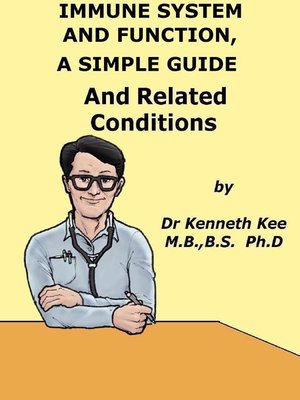
Sign up to save your library
With an OverDrive account, you can save your favorite libraries for at-a-glance information about availability. Find out more about OverDrive accounts.
Find this title in Libby, the library reading app by OverDrive.



Search for a digital library with this title
Title found at these libraries:
| Loading... |
Chapter 1
The Immune System
What is immunity?
Immunity can be defined as protection from infection such as bacteria, virus, fungus, foreign body.
There are different kinds of immunity.
This topic is about how different parts of the bodies work together to keep us from getting sick.
Immunity to some diseases is passed on from our mothers before we are born.
Immunization (having the 'shots') helps the body's immune defense system protect us from diseases.
The body's immune system
Every body has an inbuilt immune system which protects it from diseases and germs.
This system has a lot of different parts which work together to keep out any harmful germs, and attack and destroy any which manage to get inside the body
Every day the body is exposed to millions of germs, and you do not get sick from them because of the immune system.
We are surrounded by millions of bacteria, viruses and other microbes (germs) that have the potential to enter our bodies and cause harm.
The immune system is the body's defense against pathogens (disease-causing microbes).
The immune system is made up of non-specialized defenses such as skin and the acidic juice produced by the stomach.
But it also has some highly specialized defenses which give you immunity against (resistance to) particular pathogens.
These defenses are special white blood cells called lymphocytes.
Other types of white blood cells play an important part in defending the body against infection.
Every time you do get sick because of a germ, the immune system works to get rid of it and then it remembers how to fight the infection if the same germ comes again.
Usually the older you get, the more germs you become immune to.
So let's have a look at the immune system, starting from the outside of the body.
A. General Defenses
a. The skin
The skin is the first line of defense in the immune system.
Well the skin is like a plastic wrap to keep germs from getting into the body.
The epidermis (outside layer of skin) has special cells which warn the body about incoming germs.
Glands in the skin also make substances that can kill some bacteria (anti-bacterial chemicals).
This means you do not get infections on the skin unless the skin is damaged, such as by a cut or a graze.
b. Mucosal defenses
The nose, mouth and eyes are the next point of attack.
The mucous membranes which line the mouth, throat, lungs and bowel, act like a barrier to germs, just as the skin does.
Saliva in the mouth and the tears which wash the eyes has special enzymes (chemicals) in them which break down the cell walls of many bacteria and viruses.
The mucous, that is made in the nose, throat and lungs traps bacteria, viruses and dust.
c. Chemical Defenses
Acid in the stomach kills most germs, and starts to digest the food.
d. Cough reflex
Throat irritated by germs will be stimulated by the cough reflex to cough them out of the body
e. Gut micro-organisms
Good bacteria in the bacterial flora of the intestine like lactobacillus not only produce vitamins like vitamin K but also help to get rid of bad bacteria
B. Types of Immune System
The immune system is a network of cells, tissues and organs, found throughout the body that combats infectious disease and cancers.
It is divided into 'innate' and 'adaptive' immune responses.
a. Innate immunity
The 'innate' (meaning: "present from birth" and "operates throughout life") part of the immune system is so-called because it...






